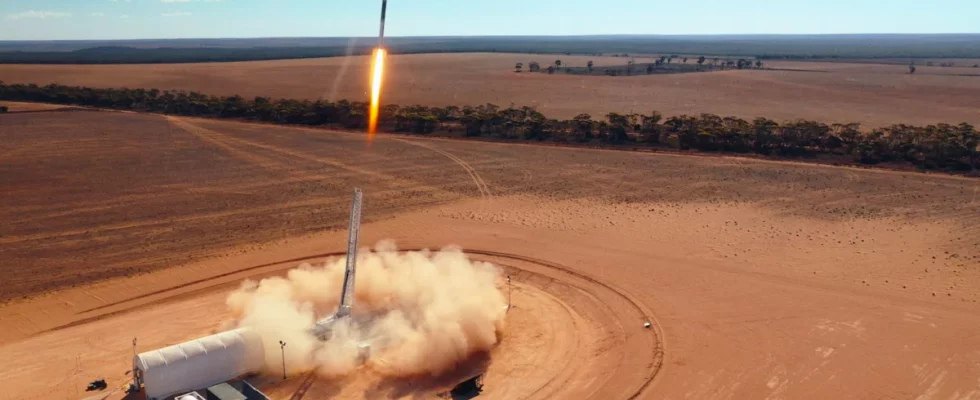It’s only the first step towards space, but they say they’ve managed the test: The start-up Hyimpulse from Neuenstadt near Heilbronn launched its first small rocket on Friday. The twelve-meter-tall launch vehicle SR75 took off from the launch site in Koonibba, South Australia, at 7:10 a.m. Central European Summer Time. The sounding rocket has reached 50 to 60 kilometers as planned; it will only be released into space during the next test. The team will only be able to say how high the rocket actually flew in a few days, once they have recovered and evaluated the flight recorder.
What was unusual about the flight was that paraffin, i.e. candle wax, powered the rocket, plus liquid oxygen. Paraffin is non-explosive, easy to obtain, easier to regulate, and safer and cheaper than other fuels. This makes the drive system about half cheaper than conventional engines, claims Hyimpulse.
Co-chief executive Christian Schmelzer spoke of a “successful start, which also provides us with valuable data for further development”. “We are sending an important signal for Germany as a space nation and have opened Europe’s door to space a crack,” said co-chief Mario Kobald. The SR75 with a payload capacity of 250 kilograms, was just an intermediate step for the start-up to a larger launch vehicle. The SL1 should be 32 meters tall and be able to place satellites weighing up to 600 kilograms in low Earth orbit. The multi-stage rocket will also be fueled with candle wax and will launch at the end of next year – probably from the Shetland Islands.
Hyimpulse wants to make money with both types of rockets. Sounding rockets usually carry out scientific measurements in the atmosphere, but they can also transport small satellites. The need for commercial transport rockets in Europe is huge. “Accordingly, we already have a high volume in the order book of well over 100 million euros,” said Stricher. A launch of the larger rocket SL1 cost around six million euros. The company wants to charge around 7,000 euros per kilogram of payload. Customers include the automotive industry, which needs satellites for navigation and autonomous driving.
With the current test flight, Hyimpulse is also hoping for further investors. The founders still need 70 to 80 million euros in capital before the microlaunch can start. The main investor so far is the holding company of entrepreneur Rudolf F. Schwarz, which runs the space test company IABG. Hyimpulse has so far raised a total of around 25 million euros.
Isar Aerospace and RFA also want to start soon
In addition to Hyimpulse, the start-ups Isar Aerospace and Rocket Factory Augsburg are also in the process of building a commercial small rocket. They could probably take off in the second half of the year. Each of these is already a larger microlauncher that could bring a ton or more into Earth orbit. The Spanish company PLD has also launched a suborbital rocket in autumn 2023 and is working on a larger version. There are several microlauncher start-ups across Europe. For comparison: the new ESA rocket Ariana 6which is scheduled to start for the first time in the summer, should be able to transport around ten to 20 tons, depending on the type.
Former astronaut Ulrich Walter sees many opportunities for private manufacturers of smaller rockets. Especially since satellites are becoming smaller and smaller. The new small rocket providers are more flexible than the larger ones, where you have to book a place two years in advance. The market will grow significantly in the future, said the professor of space technology at the Technical University of Munich to the dpa. Esa boss Josef Aschbacher wants European start-ups to build larger rockets in the 1930s in order to compete with the Ariane rocket.
A new one McKinsey study According to this, the space-based economy could grow significantly faster than the global gross domestic product at nine percent per year in the next few years. “Sales will rise from $630 billion today to $1.8 trillion in 2035,” analyze the market researchers. This would result in a similar size to the semiconductor industry.
The German company Otrag had already developed a launch vehicle in the late 1970s and tested it in Africa. “In today’s language, Otrag would be described as a start-up,” says Walter. The company Otrag (Orbital Transport and Rocket Corporation) said it had stopped production and research at the end of 1984.

